in popular culture
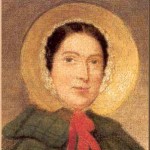 Miss Anning as a child ne’re found
Miss Anning as a child ne’re found
A pin upon the ground
But picked it up and so at last
An Ichthyosaurus found
– J. W. Preston, 1884
For the last two centuries, adults have found Mary Anning a useful model in cajoling kids to work hard, make the best of bad circumstances, and pick up pins. She’s the heroine of close to 20 children’s books, which sometimes picture her skipping across the foreshore in a pinafore.
Then of course there’s the tongue-twister Anning inspired, part of a verse by Terry Sullivan:
She sells seashells on the seashore
The shells she sells are seashells, I’m sure
So if she sells seashells on the seashore
Then I’m sure she sells seashore shells.
In 1865, 18 years after Mary Anning’s death, Charles Dickens wrote an amusing and generous piece about her in his magazine All the Year Round (vol.13). “[Geology] was not a science when she began,” he 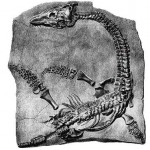 observes, “but she made it one.”The article is fascinating for its observations about the fossils. He calls the pterodactyl Mary found in 1828, “Nature’s first attempt at anything in the bird line,” and describes the plesiosaur as “half vampire, half woodcock.” Commenting on the ichthyosaurus’s huge eyes, Dickens claims that some specimens were so perfect that you could peel thirteen layers of petrified lense off the eyes to use as magnifying glasses. Really?
observes, “but she made it one.”The article is fascinating for its observations about the fossils. He calls the pterodactyl Mary found in 1828, “Nature’s first attempt at anything in the bird line,” and describes the plesiosaur as “half vampire, half woodcock.” Commenting on the ichthyosaurus’s huge eyes, Dickens claims that some specimens were so perfect that you could peel thirteen layers of petrified lense off the eyes to use as magnifying glasses. Really?
In the last 6-7 years, Mary Anning suddenly seems to be part of the zeigeist – she even scored a mention in Bill Bryson’s A Short History of Nearly Everything (Black Swan/Broadway Books, 2003) and CBC Ideasran a two-part radio documentary in 2006: Inventing Dinosaurs by Seth Feldman.
in science
Anning’s full contribution to paleontology emerged only in the mid-twentieth century, when science historian William Lang (1878-1966) set about collecting papers that made reference to her. His finds, documented in articles published in the Proceedings of the Dorset Natural History and Archaeological Society, trace her career as an intuitive and persistent collector, a skilful preparer, and an informed interpreter of the Dorset/Devon fossils. 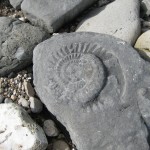
John Fowles served as curator of the Lyme Regis Philpot Museum from 1979-88, and chaired the Mary Anning Bicentennial Celebration there in 1999, the catalyst for a great deal of the Anning research and writing in the last decade. An interesting account of this symposium can be found in The Hummingbird Cabinet: A Rare and Curious History of Romantic Collectors by Judith Pascoe (Cornell University Press, 2006). It seems a rift developed between the “hard” scientists and the social historians/writers. It was the American Science writer Stephen Jay Gould (not novelist John Fowles) who got to his feet to defend fiction as one way of illuminating the past.
The appendix to Jurassic Mary: Mary Anning and the Primeval Monsters by Patricia Pierce (Sutton, 2006) provides a great summary of Anning’s finds and accomplishments, and the various collections in which primary documents can be found.Numerous Anning bibliographies are available on-line, and I won’t duplicate them here. Check out Mary Anning’s Wikipedia page, as well as the CBC Ideas web site, which has links to other sites on the early fossilists. http://www.cbc.ca/ideas/features/dinosaurs/. An article by Hugh Torrens (who delivered the keynote address at the Mary Anning Bicentennial) is a comprehensive summary of Anning scholarship and lore to 1995: “Mary Anning of Lyme: The Greatest Fossilist the World Ever Knew” (British Journal of the History of Science, vol. 28).
And in the last year a full length biography has been published: The Fossil Hunter: Dinosaurs, Evolution, and the Woman whose Discoveries Changed the World by Shelley Emling (Palgrave/MacMillan, 2009). It’s not the definitive academic biography some may be waiting for–the author admits in the prologue to taking certain “liberties”– but it’s highly readable and quite comprehensive.
in the museums
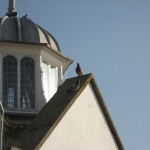 Lyme Regis Philpot Museum was built by the nephew of the three Philpot sisters, initially to house their collection, and is situated almost on the site of the Anning house on Bridge Street. It’s a beautiful little museum, and a good portion of it is devoted to Mary Anning. http://www.lymeregismuseum.co.uk
Lyme Regis Philpot Museum was built by the nephew of the three Philpot sisters, initially to house their collection, and is situated almost on the site of the Anning house on Bridge Street. It’s a beautiful little museum, and a good portion of it is devoted to Mary Anning. http://www.lymeregismuseum.co.uk
Dorset County Museum, Dorchester houses an Anning collection in its archives, which includes numerous letters, Mary’s only surviving commonplace book (into which she copied hymns, comic verse, and scientific articles) and transcriptions of the portions of Anna Maria Pinney’s fascinating journal that pertain to Mary Anning.
Natural History Museum, London. Mary Anning’s contribution to paleontology is nowhere more evident than in the Fossil Marine Reptiles gallery of the Natural History Museum. Mounted on the wall are the two significant fossil finds recounted in Curiosity: the 1810-11 Ichthyosaur (its head only—the body was apparently lost during the Blitz) and the 1823 plesiosaur, as well as many other Anning finds; it’s impossible to know how many of the specimens displayed are in fact Anning’s, because she contributed so heavily to the collections of others like Hawkins, Sedgewick, Buckland and Conybeare. Anning’s portrait was hung in the gallery several years ago as an acknowledgement of her work.
In the museum’s Earth Sciences Library, you can examine Mary’s hand-copy of the Conybeare-De la Beche article on the Ichthyosaur (with the poignant footnote, “When I write a paper there shall not be but one preface.”), the catalogue of the auction sale arranged by Colonel Thomas Birch as a benefit for the Annings, Mary’s sketch and notes about the plesiosaur find, and (on the back of a hand-copy of an article on belemnites), a sketch of her dog.
in her later years
Mary Anning remained in Lyme Regis her entire life, although she took one highly-anticipated trip to London as the guest of some of her middleclass friends, where she visited the British Museum. She continued to collect, and was responsible for three further significant finds: a pterodactyl (Dimorphodon macronyx, 1828), a fossil fish (Squaloraja polyspondyla, 1829), and a big-headed plesiosaur (Plesiosaurus macrocephalus, 1830).
On-line accounts provide good summaries of Mary Anning’s accomplishments and later life, and of the too-little-too-late decision of the fossiling-gentlemen to keep her from starvation with a bit of regular cash. I’ll just add that, based on my research, it was clear to me that life became progressively harder for Mary as time went on, that she was worn down by hard work and poverty, more and more resentful of the lack of recognition, and increasingly outspoken and eccentric. George Roberts’ vague insult in the History of Lyme Regis and Charmouth (1834) speaks of a general lack of respect in the town: “Although the subject of this notice [Mary Anning] might not be disparaged by a description more strictly personal, yet such might be unpleasant.” And while the journal of Anna Maria Pinney portrays Mary as a vigorous and forthright woman, you also sense in their intense encounters, in Mary’s eagerness to confide is a virtual stranger 15 years younger than herself, a rather desperate hunger for connection.
Mary Anning died in 1847 of breast cancer. An 1857 book called The Beauties of Lyme Regis noted that “her death was, in a pecuniary point, a great loss to the place, as her presence attracted a large number of distinguished visitors.” But the window erected in her memory in St. Michael’s Church in Lyme Regis bears a kinder inscription:
 This window is sacred to the memory of Mary Anning of this parish, who died 9 March AD 1847 and is erected by the vicar and some members of the Geological Society of London in commemoration of her usefulness in furthering the science of geology, as also of her benevolence of heart and integrity of life.
This window is sacred to the memory of Mary Anning of this parish, who died 9 March AD 1847 and is erected by the vicar and some members of the Geological Society of London in commemoration of her usefulness in furthering the science of geology, as also of her benevolence of heart and integrity of life.
Here is the text of the eulogy the recently-knighted Sir Henry De la Beche delivered at the Geological Society in 1848.
“I cannot close this notice of our losses by death without adverting to that of one, who though not placed among even the easier classes of society, but one who had to earn her daily bread by her labour, yet contributed by her talents and untiring researches in no small degree to our knowledge of the great Enalio-Saurians, and other forms of organic life entombed in the vicinity of Lyme Regis. There are those among us in this room who know well how to appreciate the skill she employed (from her knowledge of the various works as they appeared on the subject) in developing the remains of the many fine skeletons of Ichthysauri and Plesiosauri, which without her care would never have been presented to the comparative anatomists in the uninjured form so desirable for their examination. The talents and good 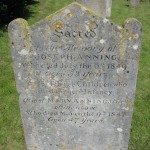 conduct of Mary Anning made her many friends; she received a small sum of money for her services, at the intercession of a member of this Society with Lord Melborne, when that nobleman was premier. This, with some additional aid, was expended upon an annuity, and with it, with kind assistance of friends at Lyme Regis, and some little aid derived from the sale of fossils when her health permitted, she bore with fortitude the progress of a cancer on her breast, until she finally sunk beneath its ravages on the 9th of March, 1847.”
conduct of Mary Anning made her many friends; she received a small sum of money for her services, at the intercession of a member of this Society with Lord Melborne, when that nobleman was premier. This, with some additional aid, was expended upon an annuity, and with it, with kind assistance of friends at Lyme Regis, and some little aid derived from the sale of fossils when her health permitted, she bore with fortitude the progress of a cancer on her breast, until she finally sunk beneath its ravages on the 9th of March, 1847.”